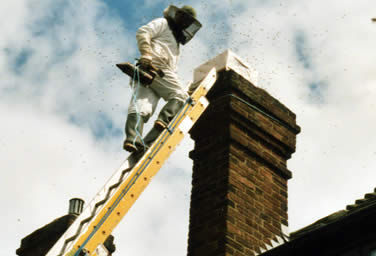You have a Honeybee Swarm who are you going to call?

To find a swarm collector, please see the “swarm” page on the BBKA’s Website.
All KBKA swarm collectors, and those of neighbouring associations, are listed there.
Before contacting any, however, please check that it is a swarm of honey bees (there is information to help you on that page), and make sure you know the exact location of the swarm (including the postcode, if possible). It also helps if you take a photograph showing where the swarm is, and how easy it is to reach.
Most beekeepers do not charge for removing a swarm, but may need to cover reasonable travel costs, so please check this when you contact a swarm collector.
Finally, please remember that swarm collectors are volunteers and amateurs, who aren’t skilled, equipped or insured for anything more than beekeeping. We can collect swarms, if it’s safe to do so, and can be done without damaging property or risking anyone’s safety, but we cannot guarantee to be able to remove every swarm.


Good Morning
I currently have a swarm of honey bees in a tree that I have begun to cut down. The bottom half of the tree has been left as this is where they are currently living. They are not currently an issue but if they are of interest to a local bee keeper please feel free to contact me.
I am located in Hoo, Rochester.
Have swarm of honey bees in a busy place near a park in Biggin Hill that need removing please.
The best and quickest way to find a swarm collector is via the BBKA’s page at http://www.bbka.org.uk/swarm
The KBKA is a member association of the BBKA, so KBKA swarm collectors are listed there along with swarm collectors from neighbouring associations.
We have a swarm on tree. Please collect it URGENTLY!!!!!
4 Sliles close, Minster on Sea. Seerness, Kent ME12 2TQ
To find a swarm collector, please see the BBKA’s page at http://www.bbka.org.uk/swarm
The KBKA is a member association of the BBKA, so KBKA swarm collectors are listed there along with swarm collectors from neighbouring associations.
Hi, I believe I have a swarm in my roof. We have seen many around and I’ve seen a few flying in a hole in the roof tiles.
The thing is I’ve always wanted to keep bees.but I’m not experienced. I have been considering for a long time “renting” our land in exchange for honey. Would someone be able to take this swarm.and safely reallocate them into a hive nearby on our land? We have lots of space, a woodland and have planted a two wildflower gardens too so we think the area is perfect for them. Of anyone can advise would be great!
Hello. If it’s in the roof, then it won’t be a swarm we can collect, but an established colony. It might not have been established for long, or you might not have noticed it before – a lot of roof-spaces, and chimneys, are home to bees – but it’ll have built a nest and that will make it tricky to remove.
That’s mostly because, unlike wasps, honey bees build their nests in cavities. An airbrick leading to a space above a ceiling, for example, is ideal for them to live in, as it’s sheltered and warm and out of the way. That’s great, but being out of the way doesn’t just mean they can’t bother you, it makes it difficult to bother them. Not without taking down ceilings or removing roof-tiles or taking up floorboards. And, once you’ve cut a hole in the ceiling or the floor or whatever, the bees won’t be living in a cavity any more. They’ll be living in your home.
Sure, the nest might then be removed. A beekeeper, wearing a proper veil and gloves and so on, will be able to carefully cut the comb away from the boards above it, and carefully transfer it into a travelling box. The comb, however, is the easy bit. The comb can’t fly. The bees, however, can fly and, in a year-old nest there may be 20,000 bees in the daytime. So even if the beekeeper is very, very charming, and gets half the bees in the box, that’ll leave 10,000 flying around, looking for their nest. Meanwhile, there’ll be another 20,000 outdoors collecting food and, sooner or later, each and every one of those will head home, too. They might, if the queen is somehow left behind, start to build another nest. Or they might just buzz around your house, getting annoyed and tired and injured. They will remember where their home is, and if their nest is gone, they’ve nowhere else to go.
To solve that, it’s sometimes possible to hang the box with the comb in it near where the bees were entering the building. Though, if it’s a small hole two or three storeys up, it can be difficult to find any where to hang anything. And that’ll only work if the queen is the box, which is not easy to guarantee. If not, then the bees that are in the box already, may come out of the box, and make the problem worse. Either way, though, it’s not a quick process, and may take a few days.
I have seen this done, and it was very interesting to watch. But I wouldn’t recomment it. As things are, both you and the bees are living quietly in the same building, without annoying each other at all. It might not be a good idea to try change that. Not just because it’s difficult but because, what then? If your roof has attracted to one colony of bees, it is bound to attract another, sooner or later.
Bee-keepers, however, are always looking for new sites to keep bees on, so I’m sure there would be some locally who’d be interested in your suggestion. The best place to ask would be your nearest branch. There’s a map at https://www.kbka.org.uk/branches that shows where they all are. Sadly, we’re not having meetings at present, but they’d be happy to hear from you. If it’s not clear, an email or call to the secretary will usually find them, though some have Facebook groups now.